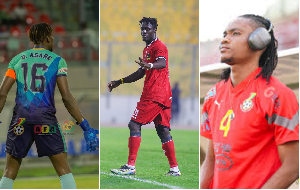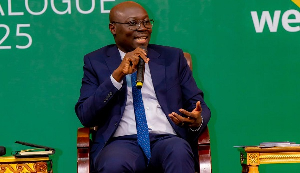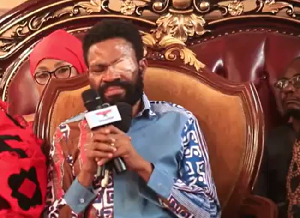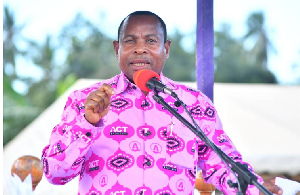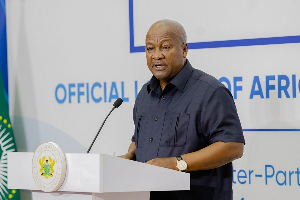…. the “Buy-One-Get-One” program for the “$100 Laptop” kicks off tomorrow (12 Nov 07)…45 days before the end of the 2007 tax year. Many Americans and private corporations may never be in a better position to help Ghana’s children. Question is, where are Ghana’s visionary leaders? Where are the leaders who are effectively plugged into the current information society…who…know what to do, how to go about it, how to truly make a difference for Ghana’s children and the nation?... According to OLPC, beginning…November 2007, the price per machine is $200 for individuals who order two… Reportedly, Uruguay paid approx $188 per laptop. Rwanda signed up…and…will be receiving some free “$100 Laptops” for its children… (Prof Lungu, 20 Nov 2007)
Recent news is, (a) 1,000 units of those “$100 Laptops” have arrived at the Tema port, (b) the NDC government, according to Dr Kwabena Duffuor, has paid GH¢23,239.12 for “clearing and storage,” and (c) all this started because in October 2008, the NPP government ordered 10,000 of those laptops at a cost of $2,050,000.00 (or $205 each).
We will remind the reader that our original piece about the “$100 Laptop” appeared on Ghanaweb 20 Nov., 2007. Back then, we reported in part that Uruguay had purchased 100,000 of those laptops at a cost of $188 each, and had ordered an additional 300,000 to be delivered by 2009. In that piece, we asked why not for Ghana’s school children given that it was Ghana’s own Mr. Kofi Annan, who, back in 2005, unveiled the “$100 Laptop” as a development/education leap-froger for poor nations. What we did not tell you is this: Uruguay’s purchase practically allotted one laptop for each of Uruguay’s school children between the ages of 7 and 14.
Done! Nothing to study!
Fast track to Ghana!
We know now that the previous government attempted to do something about the “$100 Laptop.” In fact, they called it the “Baah-Wiredu Laptop.” However, it appears the NPP folks and the people at the Ghana education and finance ministries did not go about it transparently, wisely, or accountably. Therefore, it is welcome news that the current administration “will withhold payment for the remaining 9,000 laptops pending a “proposed” review of the transaction." We think that the review must be more than “proposed.” We think that the review is in order and should be accomplished quickly. But it must be done transparently and accountably.
The Prof. Mills administration may want to consider the following 8 (eight) simple questions:
1. Why did Ghana, in October, 2008, pay $205 for each machine when (a) Uruguay paid $188 for each unit in 2007, (b) OLPC told the world that beginning 12 November 2007, the price per machine was $200 even for individuals who order only two, and (c) the Mr. Kuffour administration intended to order 1 million “$100 Laptops” for Ghana’s children?
2. Why didn’t the NPP Government simply contact the Government of Uruguay and other countries that were the first to order the laptops for program evaluation data?
3. Relatedly, why did MOFEP and MOESS “request three companies to pilot ‘their laptops’ in two to five primary schools, for…six months, to ascertain their robustness, user-friendliness, and durability”? How much was paid to the 3 companies and what exactly were they supposed to tell Ghanaians about those durable, waterproof, solar- foot-pump, pull-string powered laptops? Did the 3 companies perform reasonably, as contracted? How were they selected and what were their competencies?
4. How exactly were the 2 to 5 primary schools selected for the test program and why? (Was there fairness and regional balance, of instance?).
5. Can MOFEP and MOESS tell us why there was not attempt to leverage government resources with private charitable “assist” given the peculiar OLPC niche market and the desire and willingness by many persons inside and outside Ghana to help Ghana’s children? (Why was the information not fully published and people from all corners of the world not asked to assist?).
6. Why was the program turned over to middlemen when there are enough government officials at the education and finance ministries to order directly from the OLPC Foundation? Who made that decision and why?
7. The OLPC laptop is a very small box that weighs about 2 pounds. Given that the average total cost of a 40-ft container from the US to Tema is not higher than $10,000, why did the Government of Ghana pay GH¢23,239.12 (over $20 per unit/$10 per pound) for “clearing and storage” from the government’s own terminal/port, for 1,000 OLPC laptops? How much did it cost to ship and insure, besides “clearing and storage.”
8. What is the total cost for the program so far (to include laptops, travel, contractor support, agent fees, shipping, clearing, transportation, etc.?). Why?
ITEM: As part of the review, we suggest the government contact OLPC directly. Reviewers should not hide anything from the people. As we said back in 2007, the OLPC program will be a transparent one. The OLPC is a US registered charitable foundation doing business as a tax-exempt entity. That means that US citizens and corporations that make “donations”, including purchases for others (read Ghana’s school children) would be able to deduct a portion of amount expended from their federal income tax. Thus, there are strong accounting and reporting requirements, via the Internal Revenue Service (IRS). And it is a lot easier in this case because we are dealing with “$100 Laptops.”
What is the shame, you ask?
The shame is, back in 2008 when the NPP government was ordering the machines, they neglected to fully publicize the program. They neglected to leverage limited government resources that would have allowed them to purchase even more of those already-tested laptops to quickly meet the 1 million-unit goal.
And so we must say again, what a life!
Uruguay has thought us something useful for sure something possibly great for Ghana’s school children. Vision, currency with digital/information technology, planning with/for the people, and Ghana-centeredness!
That is all it takes, in our humble opinion!
DISCLOSURE AND FINAL NOTES: 1. Turns out 1 million units get about 80 “$100 Laptops” into each of Ghana’s 12,225 primary schools, being a program target goal Prof Lungu specified in the original 2007 essay, assuming cost was a major constraint but that leap-froging development/education in Ghana was a more important goal). Recall that Uruguay is buying for each child!
2. Prof Lungu is not associated in any way with OLPC, with the Ghana Education Service, or with any NGO in Ghana.
3. Prof Lungu recognizes that public programs do not always end up supportive of program mission or agency goals. Still, we believe that a well conceptualized, leveraged, “$100 Laptop” program will work for the people. 80 laptops in each Ghanaian primary school is an achievable goal. It can be done, quickly. But it cannot be done if economy and time are important constraints and secrecy and lack of transparency are our modus operandi!
4. Interestingly, these days, individuals can actually purchase brand new, complete, internet-ready, 8-9 inch screen, laptops for less that $250. But those are not “durable, waterproof, solar- foot-pump, pull-string powered” laptops suitable for poor schools in Ghana. Consider that many of these schools do not have access to electricity.
Prof Lungu: Ghana-Centered, Ghana-Proud, Always! Brought to you in part by www.GhanaHero.com). Read about it, listen to it --- FOIB – Are You Pickable, Mr. Politician.
Powered by www.GhanaHero.com.
© Prof Lungu, Okinawa, Japan, 12 June 2009.
Opinions of Saturday, 20 June 2009
Columnist: Prof Lungu


![New IGP, COP Christian Tetteh Yohonu [L] and immediate-past IGP, Dr. Akuffo Dampare New IGP, COP Christian Tetteh Yohonu [L] and immediate-past IGP, Dr. Akuffo Dampare](https://cdn.ghanaweb.com/imagelib/pics/140/14041582.295.jpg)

